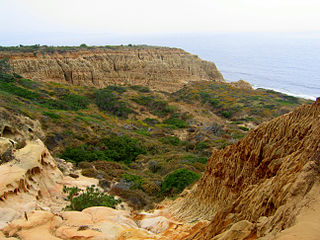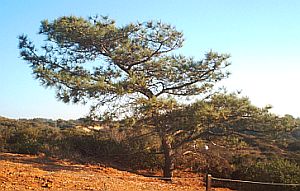
Pinus nigra, the Austrian pine or black pine, is a moderately variable species of pine, occurring across Southern Europe from the Iberian Peninsula to the eastern Mediterranean, on the Anatolian peninsula of Turkey, Corsica and Cyprus, as well as Crimea and in the high mountains of Northwest Africa.

The Torrey pine is a rare pine species in California, United States. It is a critically endangered species growing only in coastal San Diego County, and on Santa Rosa Island, offshore from Santa Barbara in Santa Barbara County. The Torrey pine is endemic to the California coastal sage and chaparral ecoregion.

Pinus contorta, with the common names lodgepole pine and shore pine, and also known as twisted pine, and contorta pine, is a common tree in western North America. It is common near the ocean shore and in dry montane forests to the subalpine, but is rare in lowland rain forests. Like all pines, it is an evergreen conifer.

Pinus muricata, the bishop pine, is a pine with a very restricted range: mostly in California, including several offshore Channel Islands, and a few locations in Baja California, Mexico. It is always on or near the coast.

Pinus ponderosa, commonly known as the ponderosa pine, bull pine, blackjack pine, western yellow-pine, or filipinus pine is a very large pine tree species of variable habitat native to mountainous regions of western North America. It is the most widely distributed pine species in North America.

Torrey Pines State Natural Reserve is 2,000 acres (810 ha) of coastal state park located in the community of La Jolla, in San Diego, California, off North Torrey Pines Road. Although it is located within San Diego city limits, it remains one of the wildest stretches of land (8 km²) on the Southern California coast. It is bordered immediately on the south by Torrey Pines Municipal Golf Course and on the north by the city of Del Mar. The reserve was designated a National Natural Landmark in 1977.

Pinus halepensis, commonly known as the Aleppo pine, also known as the Jerusalem pine, is a pine native to the Mediterranean region.

Pinus cembroides, also known as pinyon pine, Mexican pinyon, Mexican nut pine, and Mexican stone pine, is a pine in the pinyon pine group, native to western North America. It grows in areas with low levels of rainfall and its range extends southwards from Arizona, Texas and New Mexico in the United States into Mexico. It typically grows at altitudes between 1,600 and 2,400 metres. It is a small pine growing to about 20 m (66 ft) with a trunk diameter of up to 50 cm (20 in). The seeds are large and form part of the diet of the Mexican jay and Abert's squirrel. They are also collected for human consumption, being the most widely used pine nut in Mexico. This is a common pine with a wide range and the International Union for Conservation of Nature has rated its conservation status as being of "least concern".

Pinus monophylla, the single-leaf pinyon, is a pine in the pinyon pine group, native to North America. The range is in southernmost Idaho, western Utah, Arizona, southwest New Mexico, Nevada, eastern and southern California and northern Baja California.

Pinus gerardiana, commonly known as the chilghoza pine or neja is a pine native to the northwestern Himalayas in Afghanistan, northern Pakistan, Waziristan and northwestern India, growing at elevations of 1,800–3,350 metres (5,910–10,990 ft). It often occurs in association with Cedrus deodara and Pinus wallichiana.

Torrey Pines State Beach is a public beach located in the San Diego, California community of Torrey Pines, south of Del Mar and north of La Jolla. Coastal erosion from the adjacent Torrey Pines State Reserve makes for a picturesque landscape. It is a local favorite among surfers and remains a quintessential Southern California beach. Occurrences of bioluminescence in the waters near the beach have been noted.
Pinus squamata, the Qiaojia pine or southern lacebark pine, is a critically endangered pine native to a single locality consisting of about 20 trees in Qiaojia County, northeast Yunnan, China, at about 2,200 m (7,200 ft) elevation.

Pinus dalatensis, also known as Vietnamese white pine or Dalat pine, is a species of pine endemic to Indochina. In Vietnam it grows in the mountains of the central and south-central parts of the country at elevations of 1,400 to 2,300 metres. Only recently confirmed from Laos, the population located within the Nakai-Nam Theun Biodiversity Conservation Area is the largest, at the lowest elevation, and the northernmost of the known populations of P. dalatensis.
Rancho Santa Maria de Los Peñasquitos was a 8,486-acre (34.34 km2) Mexican land grant in present-day southwestern San Diego County, California given in 1823 to Francisco María Ruiz. The name means "Saint Mary of the Little Cliffs". It encompassed the present-day communities of Mira Mesa, Carmel Valley, and Rancho Peñasquitos in northern San Diego city, and was inland from the Torrey Pines State Natural Preserve bluffs.

Los Peñasquitos Canyon Preserve is an urban park in San Diego, California. Stretching approximately 7 miles (11 km), the park encompasses some 4,000 acres (16 km2) of both Peñasquitos and Lopez canyons, and is one of the largest urban parks in the United States. The preserve is jointly owned and administered by the City of San Diego and the County of San Diego.
Soledad Valley is a coastal valley in San Diego County, California at the northern end of the city of San Diego. Mention of the valley was made as early as 1850 in association with the occurrence of Pinus torreyana at the mouth of the lagoon. The colony of the endangered Torrey Pine divided by Soledad Valley is one of only two colonies of this tree in the world.

Salt pruning is the process by which saline mists generated by seawater are driven ashore by winds and thus over time alter the shape of trees or shrubs. The process degrades foliage and branches on the windward side of the plant that faces the body of saline water, more than it does the foliage on the landward side. The resultant growth form is asymmetrical, appearing "swept back" away from the ocean.
The wildlife of the Channel Islands of California is wide and diverse, including many endemic species. While the land wildlife is slightly limited, there being only one large, naturally predatory, and native mammal, the small island fox, marine life can include anything from kelp forests to great white sharks.















